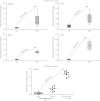Epigenetic alterations in inflammatory bowel disease and cancer
- PMID: 25931995
- PMCID: PMC4414752
- DOI: 10.5217/ir.2015.13.2.112
Epigenetic alterations in inflammatory bowel disease and cancer
Abstract
Overwhelming evidences supports the idea that inflammatory bowel disease (IBD) is caused by a complex interplay between genetic alterations of multiple genes and an aberrant interaction with environmental factors. There is growing evidence that epigenetic factors can play a significant part in the pathogenesis of IBD. Significant effort has been invested in uncovering genetic and epigenetic factors, which may increase the risk of IBD, but progress has been slow, and few IBD-specific factors have been detected so far. It has been known for decades that DNA methylation is the most well studied epigenetic modification, and analysis of DNA methylation is leading to a new generation of cancer biomarkers. Therefore, in this review, we summarize the role of DNA methylation alteration in IBD pathogenesis, and discuss specific genes or genetic loci using recent molecular technology advances. Here, we suggest that DNA methylation should be studied in depth to understand the molecular pathways of IBD pathogenesis, and discuss epigenetic studies of IBD that may have a significant impact on the field of IBD research.
Keywords: DNA methylation; Epigenomics; Inflammatory bowel diseases; Neoplasms.
Conflict of interest statement
Figures


References
-
- Kinzler KW, Vogelstein B. Lessons from hereditary colorectal cancer. Cell. 1996;87:159–170. - PubMed
-
- Bird A. DNA methylation patterns and epigenetic memory. Genes Dev. 2002;16:6–21. - PubMed
-
- Russo VEA, Martienssen RA, Riggs AD. Epigenetic mechanisms of gene regulation. New York: Cold Spring Harbor Laboratory Press; 1996.
-
- Jones PA, Laird PW. Cancer epigenetics comes of age. Nat Genet. 1999;21:163–167. - PubMed
-
- Herman JG, Baylin SB. Gene silencing in cancer in association with promoter hypermethylation. N Engl J Med. 2003;349:2042–2054. - PubMed
Publication types
LinkOut - more resources
Full Text Sources
Other Literature Sources

